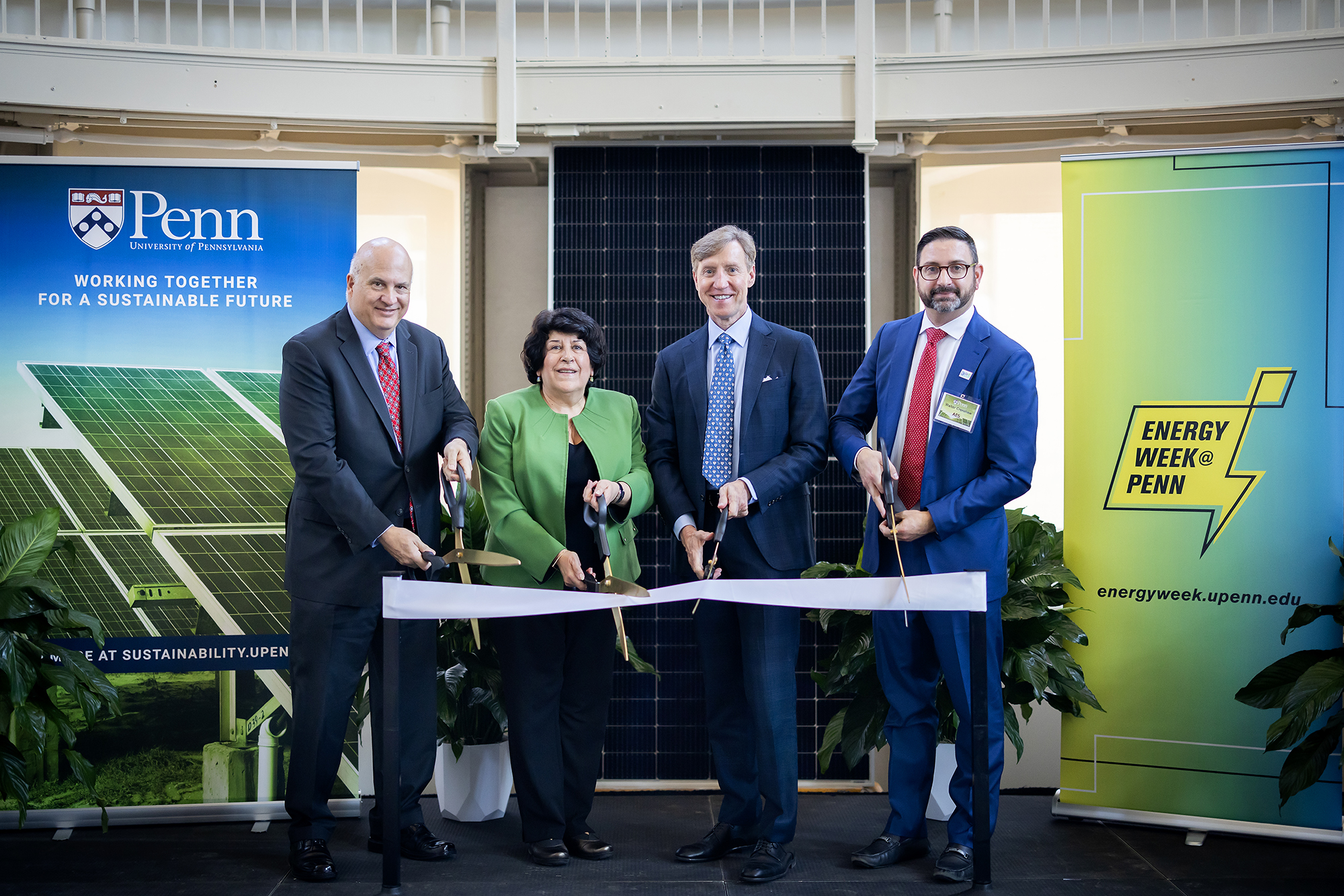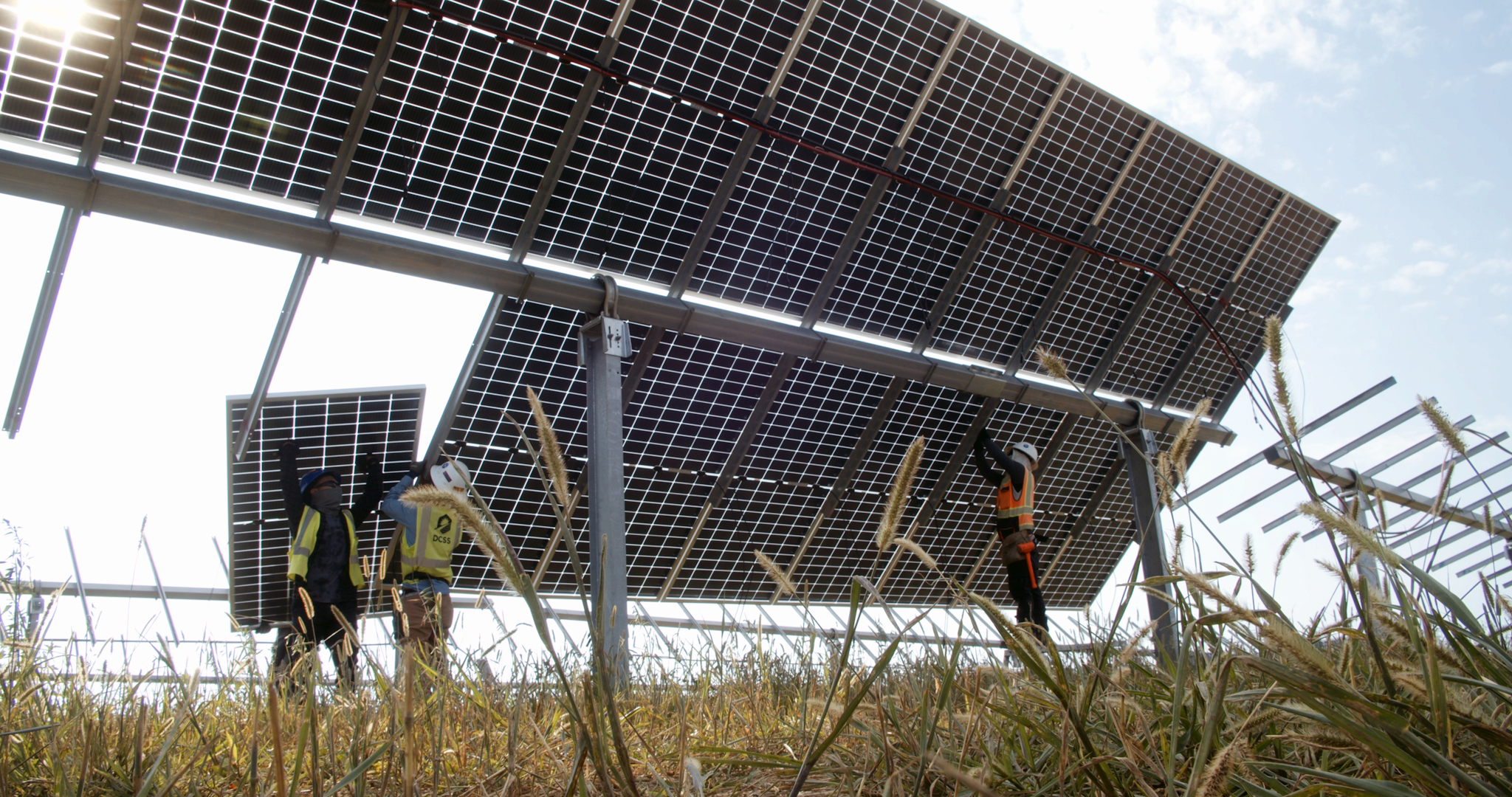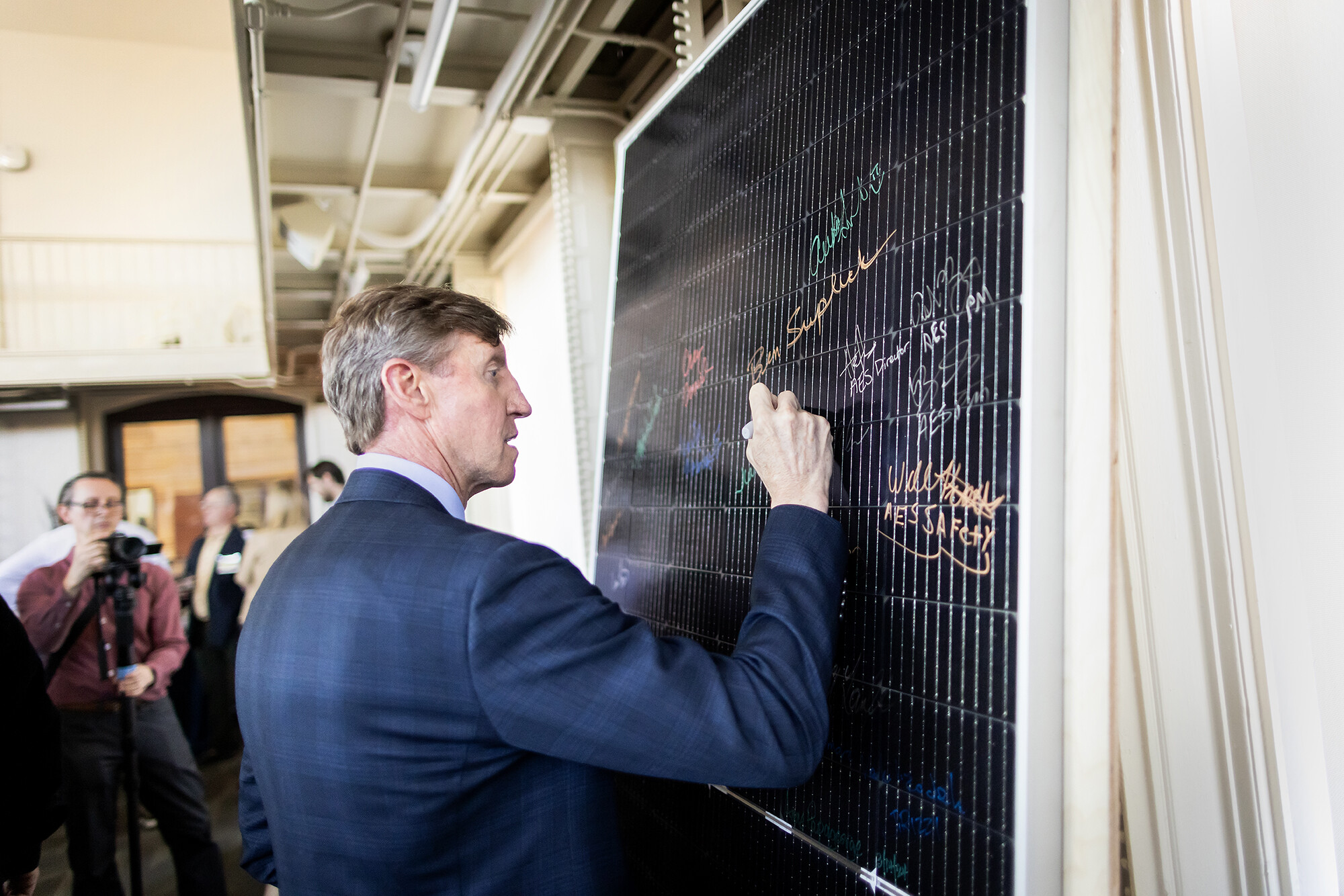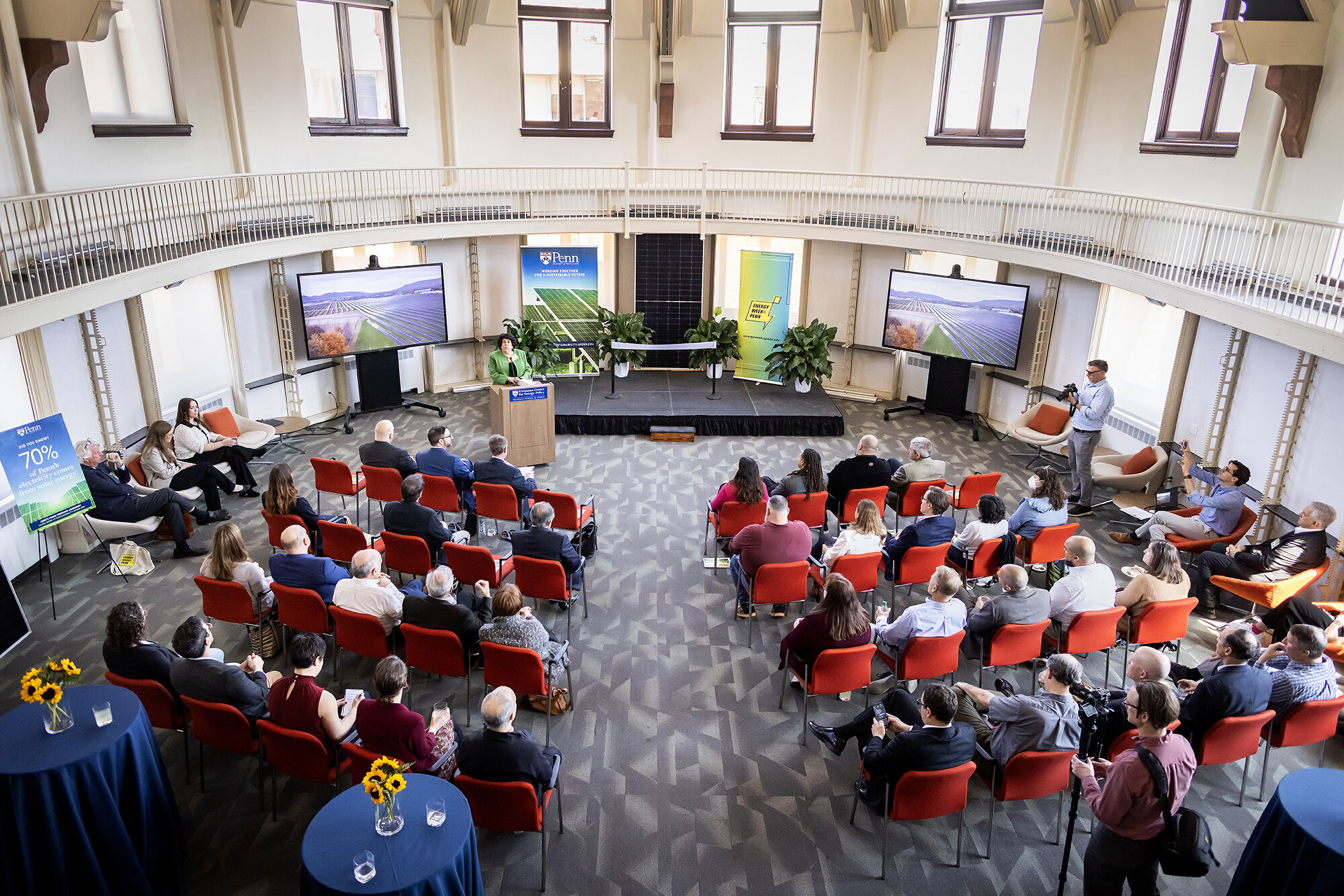
On 1,600 acres in Fulton and Franklin counties in central Pennsylvania sit two solar arrays. Comprising more than 485,000 panels, these make up the largest solar project in the Commonwealth, with a capacity of 220 megawatts. As of December, the Great Cove I and II facilities are operational, putting the University of Pennsylvania one massive step closer toward its goal of 100% carbon neutrality by 2042.
Penn will purchase all electricity produced at the facilities, the equivalent of 70% of the demand of its campus and University of Pennsylvania Health System facilities in the Philadelphia area. This stems from a Power Purchase Agreement (PPA) the University signed in February of 2020 with Community Energy, since acquired by Virginia-based global energy company The AES Corporation. Construction on the project began in April of 2022.
“I couldn’t be prouder that we’ve made such rapid, milestone progress toward carbon neutrality, not only for Penn but for the city of Philadelphia,” Interim President J. Larry Jameson said at a ceremonial ribbon cutting celebrating the PPA and the solar facilities operation during Energy Week. He added that with the University’s strategic framework, In Principle and Practice, “we’re taking on the greatest challenges of our time, and at the top of that list is climate change and sustainability.”
The partnership with AES “has been essential in meeting Penn’s goal to accelerate its adoption of renewable energy, and doing it in a way that serves the mission of our institution,” said Anne Papageorge, senior vice president of Facilities & Real Estate Services (FRES) at the ribbon-cutting, held at the Kleinman Center for Energy Policy in the Stuart Weitzman School of Design. “This agreement not only provides competitive pricing on electricity but also allows the University of Pennsylvania to continue to demonstrate strong leadership on climate action.”
The company, said Walter Crenshaw, senior director of origination at AES, “is one of the largest owner-operators and developers of renewable energy facilities in the country, but none of that really works unless we have a customer who is committed and shows leadership, like Penn.”
Years in the making
In 2007, former Penn President Amy Gutmann signed the American College and University Presidents’ Climate Commitment to develop a plan for climate neutrality. The University then formed the Environmental Sustainability Advisory Committee (ESAC) to make recommendations for accomplishing carbon reduction goals. Penn released its first Climate Action Plan in 2009 and is now operating under the Climate and Sustainability Action Plan 3.0, which laid out the pledge for carbon neutrality by 2042.
William Braham, professor of architecture in the Weitzman School of Design and co-chair of ESAC’s utilities & operations subcommittee, said the committee realized that investing in buildings alone was not going to be sufficient. They needed to look at the power supply. Penn had been purchasing wind energy from a farm in Pennsylvania, but ESAC examined what it would take to expand Penn’s portfolio of renewable energy, Braham said.
“The University gets a lot of credit, because when we started to do it, it was mostly for climate reasons: We made this pledge; we have to keep up to it,” Braham said. Then it also became apparent the University could save money over time as the cost of solar development decreased.
The University considered purchasing 50% of its electric load but later increased the amount to 70%, said Faramarz Vakili, executive director of operations and maintenance at FRES.
In 2019, after receiving plans from 30 developers, Ben Suplick, Penn’s director of engineering and energy planning and co-chair of ESAC’s utilities and operations subcommittee, said FRES narrowed it down to three companies, eventually landing on Community Energy, now AES. “The main drivers were location, cost, and our confidence in the project being able to be built,” Suplick said.
Pre-panel construction occurred from April 2022 to May 2023, ahead of solar panel installation from last May to December, and then the substation interconnection and testing occurred in November.
Vakili said AES installed more than 50 miles of medium-voltage cabling underground to connect all modules and units to the substation. He credited AES for its creative and flexible approach: The company changed its methodology and completed processes in a different order than usual because of supply chain complexities.
“We went through a pandemic during this period, which changed many things—supply chain, costs—and so what I’m most proud of is that AES’ team and our team continued to work through all of those challenges,” Papageorge said in a video created by AES. “We actually, to the month, finished the project within the schedule of the contract.”
Vakili said AES’ commercial operations were at 80% capacity in December and the project is expected to reach 100% completion by April.
Addressing Penn’s Trustees Committee on Facilities and Campus Planning in late February, Vakili said the community impact of the project included 1.1 million hours of construction work utilizing mostly local workers.
Vakili also explained how the PPA works: Penn pays AES for electricity produced by the project and the University receives Solar Renewable Energy Credits. AES then sells the generated solar power to PJM, a regional transmission organization that coordinates the transfer of wholesale electricity in all or parts of 13 states, and Penn receives a credit based on those sales.
Land of purpose
Vakili said the land parcels that are now home to Great Cove I and II were previously used for dairy and crop production and were leased by AES from their owners, who were ready to retire from agriculture but wanted to retain ownership of their land.
“The farmer just likes to create something, whether it’s something that grows out of the ground or something that shines from the sky, and there’s excitement in that,” said Glenn Dice Jr., who owns some of the land that now houses the solar facilities, said in a video for AES. He noted, “You can plan for 20 to 50 years with this. That’s significant.” Kenneth Lee Glazier, another Great Cove Solar landowner, commented with a laugh, “Makes you sleep at night, to keep your bills paid.”
AES will offer three summer internships for Penn students along with two full-time positions for graduates, Vakili told Penn Trustees.
In addition, AES will provide funding to Penn for education and training associated with various aspects of renewable energy and sustainability—and it’s already happening. Hannah Winn, a master’s student in earth and environmental studies in the College of Liberal & Professional Studies and the School of Arts & Sciences, has visited Great Cove II three times since last spring for her research into how the construction of solar arrays impacts soil health and whether the soil may be sequestering carbon.
Winn explained that she took soil samples from four parcels, which she chose based on erosion concerns. She sent the samples to Cornell Soil Health Laboratory for the sake of consistency, since that’s where AES sent the baseline soil samples taken prior to construction.
Winn is still finishing research for her capstone but has already developed seven best management practices, some of which AES is already doing: reintroduction of native vegetation; soil erosion and sedimentation control; grazing; agrivoltaics systems; soil health restoration practices; solar tracking systems with panels that move; and photovoltaic array design for agriculture opportunities. She is curious what soil analysis will show in a year or two, considering construction mixed up the soil, meaning more carbon was released.
“It’s not very often that you get to work hand-in-hand with your PPA off-taker and be able to perform studies that are going to help us with insuring that the dirt that we’re building upon is safe and clean,” Riley Shea, senior project manager at AES, said in a video. “To be able to enhance that for future work is also something that we’re extremely lucky to have in working with Penn.”
Winn also experienced the evolution of Great Cove II, having visited last spring, in August, and this past January. She described it as serene to walk around parcels where the 4-by-8-foot solar panels were fully installed and grass cover had already been planted, that “it’s just you out there, and it can feel pretty vast without workers or construction around.”
“To see it go from nothing to all these panels was super stark and so cool,” Winn said, “and just to see that replicated on so many different parcels as well, and the manpower it took.”










